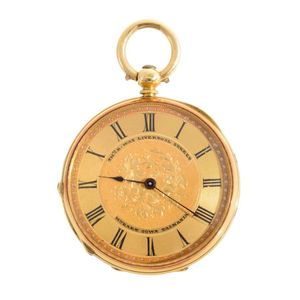English 18ct Gold Pocket Watch, London 1874-75
You must be a subscriber, and be logged in to view price and dealer details.
Subscribe Now to view actual auction price for this item
When you subscribe, you have the option of setting the currency in which to display prices to $Au, $US, $NZ or Stg.
- Movement - The technical name for the workings of a clock or watch, and does not include the dial or case.
- Fusee - The fusee movement was used in clocks and pocket watches from the mid 17th century. The fusee is a cone shaped drum within the works that is linked to the barrel of the spring, usually by a length of chain.
As the mainspring loses its tension over time, the cone shaped barrel compensates for this by increasing the tension, by pulling the mainspring tighter, thus ensuring the time remains constant.
Use of the fusee in clocks was superseded by the "going barrel" in the mid 19th century and for pocket watches at the beginning of the 19th century.
The fusee continued to be used in marine chronometers until the 1970s. - Gilding - Gilding is a method of ornamentation whereby a thin sheet of gold metal is applied to items made of wood, leather, ceramics, glass and silver for decorative purposes.
For furniture including mirrors, the sheet of gold is usually applied over a coating of gesso. Gesso is a mixture of plaster of Paris and gypsum mixed with water and then applied to the carved wooden frames of mirrors and picture frames as a base for applying the gold leaf. After numerous coats of gesso have been applied, allowed to dry and then sanded a coat of "bole", a usually red coloured mixture of clay and glue is brushed on and allowed to dry, after which the gold leaf is applied. Over time parts of the gilding will rub off so the base colour can be seen. In water gilding, this was generally a blue colour, while in oil gilding, the under layer was often yellow. In Victorian times, gilders frequently used red as a pigment beneath the gold leaf.
Metal was often gilded by a process known as fire gilding. Gold mixed with mercury was applied and heated, causing the mercury to evaporate, the long-term effect of which was to kill or disable the craftsman or woman from mercury poisoning. The pursuit of beauty has claimed many victims, not the least of which were the artists who made those pieces so highly sought after today.
This item has been included into following indexes:
Visually similar items

An open face gold pocket watch, key wind movement, circular golden dial with Roman numerals, 18ct gold case, hallmarked London 1834, maker cap, 38 mm diameter

An English 18ct gold open face pocket watch, c.1876, consular case with gold dial and Roman numerals. Fusee and chain lever movement by N. Lawrence N.45179. Width 50 mm. TW 97gms.

A rare early antique Australian ladies open face gold pocket watch, key wind and set movement, circular gold dial with Roman numerals, signed dial, movement and curvet, Thos. B. Way Liverpool Street Hobart Town Tasmania, case signed G. Chopard, 18ct gold c

W Ehrhardt London An 18ct gold open-faced watch mvt 73156 English circa 1880, english lever movement signed and numbered W. Ehrhardt no. 73156, gold engine-turned dial, foliate engraved centre, Roman numerals, blued steel hands, foliate engraved case, move
